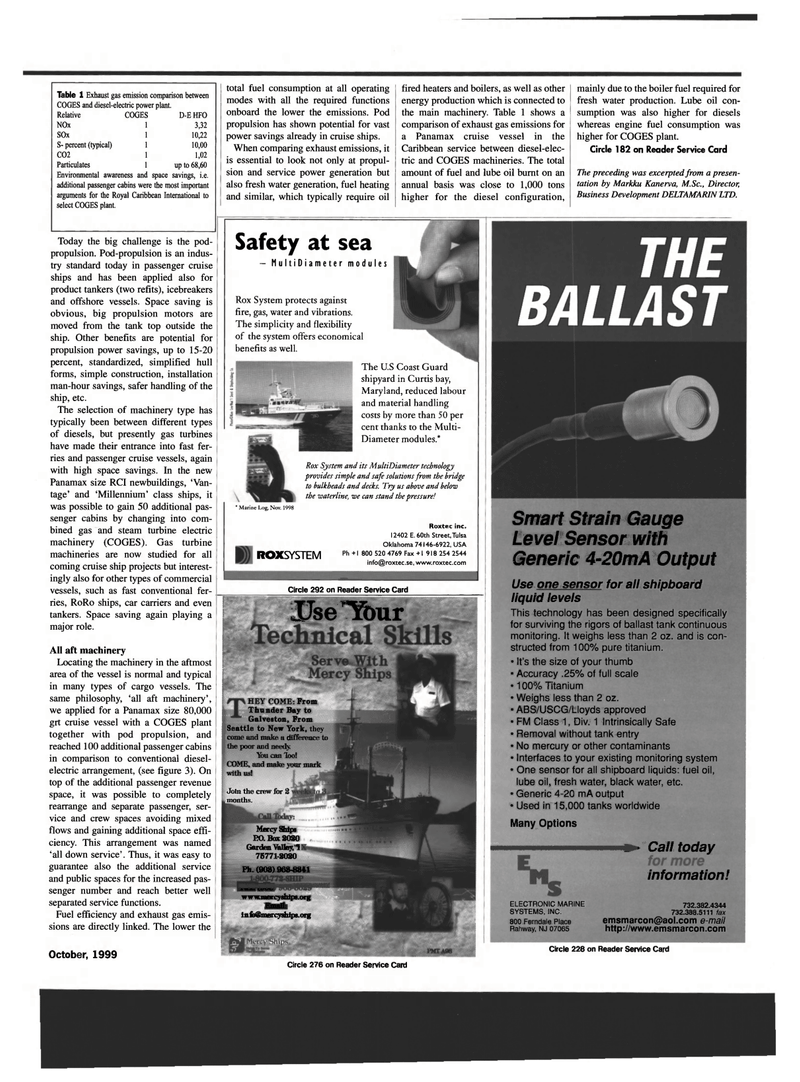
Page 57: of Maritime Reporter Magazine (October 1999)
Read this page in Pdf, Flash or Html5 edition of October 1999 Maritime Reporter Magazine
Table 1 Exhaust gas emission comparison between
COGES and diesel-electric power plant.
Relative COGES D-E HFO
NOx 1 3,32
SOx 10,22
S- percent (typical) 1 10,00
C02 1 1,02
Particulates 1 up to 68,60
Environmental awareness and space savings, i.e. additional passenger cabins were the most important arguments for the Royal Caribbean International to select COGES plant. total fuel consumption at all operating modes with all the required functions onboard the lower the emissions. Pod propulsion has shown potential for vast power savings already in cruise ships.
When comparing exhaust emissions, it is essential to look not only at propul- sion and service power generation but also fresh water generation, fuel heating and similar, which typically require oil fired heaters and boilers, as well as other energy production which is connected to the main machinery. Table 1 shows a comparison of exhaust gas emissions for a Panamax cruise vessel in the
Caribbean service between diesel-elec- tric and COGES machineries. The total amount of fuel and lube oil burnt on an annual basis was close to 1,000 tons higher for the diesel configuration, mainly due to the boiler fuel required for fresh water production. Lube oil con- sumption was also higher for diesels whereas engine fuel consumption was higher for COGES plant.
Circle 182 on Reader Service Card
The preceding was excerpted from a presen- tation by Markku Kanerva, M.Sc., Director,
Business Development DELTAMARIN LTD.
Use Your
HEY COME: From
Thunder Bay to
Galveston, From
Seattle to New York, they come and make a difference to the poor and newly %u can Too!
COME, and make your mark with us!
Join the crew for 2 months.
Mercy Ships
BO. Box 3030
Garden Valley, 1 75771-3030
Ph. (908) 968-8841 (MS W wwTiEmercyshlps.org
Email: [email protected]
Circle 228 on Reader Service Card
All aft machinery
Locating the machinery in the aftmost area of the vessel is normal and typical in many types of cargo vessels. The same philosophy, 'all aft machinery', we applied for a Panamax size 80,000 grt cruise vessel with a COGES plant together with pod propulsion, and reached 100 additional passenger cabins in comparison to conventional diesel- electric arrangement, (see figure 3). On top of the additional passenger revenue space, it was possible to completely rearrange and separate passenger, ser- vice and crew spaces avoiding mixed flows and gaining additional space effi- ciency. This arrangement was named 'all down service'. Thus, it was easy to guarantee also the additional service and public spaces for the increased pas- senger number and reach better well separated service functions.
Fuel efficiency and exhaust gas emis- sions are directly linked. The lower the
Smart Strain Gauge
Level Sensor with
Generic 4~20mA Output
Use one sensor for all shipboard liquid levels
This technology has been designed specifically for surviving the rigors of ballast tank continuous monitoring. It weighs less than 2 oz. and is con- structed from 100% pure titanium. • It's the size of your thumb • Accuracy ,25% of full scale • 100% Titanium • Weighs less than 2 oz. • ABS/USCG/Lloyds approved • FM Class 1, Div. 1 Intrinsically Safe • Removal without tank entry • No mercury or other contaminants • Interfaces to your existing monitoring system • One sensor for all shipboard liquids: fuel oil, lube oil, fresh water, black water, etc. • Generic 4-20 mA output • Used in 15,000 tanks worldwide
Today the big challenge is the pod- propulsion. Pod-propulsion is an indus- try standard today in passenger cruise ships and has been applied also for product tankers (two refits), icebreakers and offshore vessels. Space saving is obvious, big propulsion motors are moved from the tank top outside the ship. Other benefits are potential for propulsion power savings, up to 15-20 percent, standardized, simplified hull forms, simple construction, installation man-hour savings, safer handling of the ship, etc.
The selection of machinery type has typically been between different types of diesels, but presently gas turbines have made their entrance into fast fer- ries and passenger cruise vessels, again with high space savings. In the new
Panamax size RCI newbuildings, 'Van- tage' and 'Millennium' class ships, it was possible to gain 50 additional pas- senger cabins by changing into com- bined gas and steam turbine electric machinery (COGES). Gas turbine machineries are now studied for all coming cruise ship projects but interest- ingly also for other types of commercial vessels, such as fast conventional fer- ries, RoRo ships, car carriers and even tankers. Space saving again playing a major role.
October, 1999
Circle 276 on Reader Service Card
Many Options ^ Call today information! 732.382.4344 732.388.5111 fax [email protected] e-mail http://www.emsmarcon.com
Circle 292 on Reader Service Card
ELECTRONIC MARINE
SYSTEMS, INC. 800 Ferndale Place
Rahway, NJ 07065
Safety at sea - MultiDiameter modules
Rox System protects against fire, gas, water and vibrations.
The simplicity and flexibility of the system offers economical benefits as well.
ROXSYSTEM
Roxtec inc. 12402 E. 60th Street,Tulsa
Oklahoma 74146-6922, USA
Ph +1 800 520 4769 Fax +1 918 254 2544 [email protected], www.roxtec.com
The U.S Coast Guard shipyard in Curtis bay,
Maryland, reduced labour and material handling costs by more than 50 per cent thanks to the Multi-
Diameter modules." * Marine Log, Nov. 1998
Rox System and its MultiDiameter technology provides simple and safe solutions from the bridge to bulkheads and decks. Try us above and below the Tiiaterline, we can stand the pressure!

 56
56

 58
58
